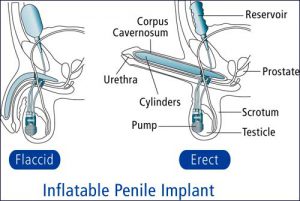Erectile Dysfunction (E.D.)
Overview

If you have difficulty getting or maintaining an erection, you are not alone. One out of two American men between the ages of 40 and 70 are affected by erectile dysfunction (ED), formerly called impotence. ED is the inability to obtain or maintain an adequate erection for sexual intercourse. While more common in older men, it can occur at any age and is not a normal part of aging. Erectile dysfunction can cause emotional damage, a loss of self-worth, depression and negative self-image for patients and their partners. This problem can greatly impact the partners and the relationship as a whole. the good news is that virtually 100% of men can resume a normal sex life with one of the many therapies available.
Symptoms
Failing to achieve and/or sustain an erection is the primary sign of ED. But diagnosing the specific cause and prescribing appropriate treatment usually require a variety of tests, beginning with a complete history and physical examination.
During sex, nerve impulses increase blood flow to the penis, causing an erection. Erection problems can be caused by a problem with blood circulation or nerve impulses to the penis, or by psychological issues that may affect performance, such as fatigue, stress, marital problems or depression.
ED can indicate an underlying medical problem such as:
- High blood pressure or atherosclerosis (blood vessel plaques)
- Diabetes
- Hormonal imbalances such as low testosterone or low thyroid
- Undiagnosed heart disease
ED also may be caused by smoking, obesity or drug use.
Diagnosis
Diagnosis-
Our urologists will carefully review your medical history and medications. Sometimes, a medical adjustment is all that is required. A physical exam will be performed, and laboratory testing is commonly obtained. Occasionally, ultrasonic imaging will aid in the diagnosis.
Treatments
NON-SURGICAL TREATMENT
Pills – The first line of therapy for uncomplicated ED is use of oral medications known as phosphodiesterase-5 inhibitors (PDE-5) which includes sildenafil citrate, vardenafil, tadalafil and avanafil (Viagra, Cialis, Levitra and Stendra). Men with ED take these pills before beginning sexual activity and the drugs boost the natural signals that are generated during sex, thereby improving and prolonging the erection itself. These medications are safe and fairly effective, with improvement in erection in nearly 80% of patients using these drugs.
Self-Injection/ Transurethral Suppositories- For men who do not respond to oral medications, another drug, Alprostadil, is FDA approved for use in men with ED. This drug comes in two forms: injections that the patient places directly into the side of the penis and a transurethral suppository. Success rates with self-injection can reach 85 percent. Modifying alprostadil to allow transurethral delivery avoids the need for a shot, but reduces the effectiveness of the agent to 40 percent. The most common adverse effects of alprostadil use are a burning sensation in the penis and the risk of over correcting the problem, resulting in a prolonged erection lasting over four hours and requiring medical intervention to reverse the erection.
External Vacuum Device – For men who cannot or do not wish to use drug therapy, an external vacuum device may be acceptable. This device combines a plastic cylinder or tube that slips over the penis, making a seal with the skin of the body. A pump on the opposite end of the cylinder creates a low-pressure vacuum around the erectile tissue, which results in an erection. To keep the erection once the plastic cylinder is removed a rubber constriction band goes around the base of the penis, which maintains the erection. With proper instruction 75 percent of men can achieve a functional erection using a vacuum erection device.
There are some men who have severe degeneration in the tissues of the penis, which makes them unable to respond to any of the treatments listed above. While this is a small number of men, they usually have the most severe forms of ED. Patients most likely to fall into this group are men with advanced diabetes, men who suffered from ED before undergoing surgical or radiation treatment for prostate or bladder cancer and men with deformities of the penis called Peyronie’s disease. For these patients reconstructive prosthetic surgery (placement of a penile prosthesis or “implant”) will restore erection, with patient satisfaction rates approaching 93 percent. Surgical prosthetic placement normally can be performed in an outpatient setting. Possible adverse effects include infection of the prosthesis or mechanical failure of the device, but their results are very low.
SURGICAL TREATMENT
Penile Implants – A penile prosthesis is an inflatable implant this is surgically placed within the penis. These have extremely high satisfaction rates: 93% satisfaction five years later (that’s better than a Maytag dryer!) Penile implants allow nearly instantaneous erections at a moment’s notice. They are under the patient’s complete control, and are completely hidden under the skin. The erection looks and feels natural, and the device can help expand and lengthen the penis. The hallmark of penile implants is that they allow for spontaneity, capability, and convenience.
They must be surgically implanted by an experience implant urologist under anesthesia. Usually performed in an outpatient setting at a surgery center, they are typically paid for by Medicare and most insurances.
The device works by means of two inflatable cylindrical tubes placed within each of the two erection channels in the penis. These tubes are connected to a small pump in the scrotum (the sack where the testicles reside) and fluid within the system allows for the implants to fill. Afterwards, a single push of a button on the pump will allow immediate deflation.
Surgical complication rates are low, but the most concerning is device infection which occurs in less than 5% of cases. Patients do have short term discomfort for which narcotics are useful. Within six weeks of surgery, the device is usable. The devices typically last 10-15 years before needing replacement.
Lifestyle Changes
The choices we make in life can lead to degeneration of the erectile tissue and the development of ED. Smoking, drug or alcohol abuse, particularly over a long period of time, will compromise the blood vessels of the penis. Lack of exercise and a sedentary lifestyle will contribute to the development of ED. Correction of these conditions will contribute to overall health and may in some individuals correct mild ED. Treatment of many medical conditions can interfere with normal erections. Drugs used to treat these risk factors listed above may also lead to or worsen ED. Patients undergoing surgery or radiation therapy for cancer of the prostate, bladder, colon or rectum are at high risk for the development of ED.



